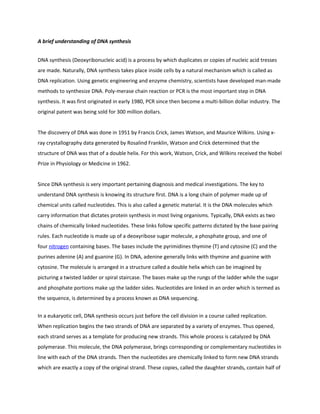
A brief understanding of dna synthesis
- 1. A brief understanding of DNA synthesis DNA synthesis (Deoxyribonucleic acid) is a process by which duplicates or copies of nucleic acid tresses are made. Naturally, DNA synthesis takes place inside cells by a natural mechanism which is called as DNA replication. Using genetic engineering and enzyme chemistry, scientists have developed man-made methods to synthesize DNA. Poly-merase chain reaction or PCR is the most important step in DNA synthesis. It was first originated in early 1980, PCR since then become a multi-billion dollar industry. The original patent was being sold for 300 million dollars. The discovery of DNA was done in 1951 by Francis Crick, James Watson, and Maurice Wilkins. Using x- ray crystallography data generated by Rosalind Franklin, Watson and Crick determined that the structure of DNA was that of a double helix. For this work, Watson, Crick, and Wilkins received the Nobel Prize in Physiology or Medicine in 1962. Since DNA synthesis is very important pertaining diagnosis and medical investigations. The key to understand DNA synthesis is knowing its structure first. DNA is a long chain of polymer made up of chemical units called nucleotides. This is also called a genetic material. It is the DNA molecules which carry information that dictates protein synthesis in most living organisms. Typically, DNA exists as two chains of chemically linked nucleotides. These links follow specific patterns dictated by the base pairing rules. Each nucleotide is made up of a deoxyribose sugar molecule, a phosphate group, and one of four nitrogen containing bases. The bases include the pyrimidines thymine (T) and cytosine (C) and the purines adenine (A) and guanine (G). In DNA, adenine generally links with thymine and guanine with cytosine. The molecule is arranged in a structure called a double helix which can be imagined by picturing a twisted ladder or spiral staircase. The bases make up the rungs of the ladder while the sugar and phosphate portions make up the ladder sides. Nucleotides are linked in an order which is termed as the sequence, is determined by a process known as DNA sequencing. In a eukaryotic cell, DNA synthesis occurs just before the cell division in a course called replication. When replication begins the two strands of DNA are separated by a variety of enzymes. Thus opened, each strand serves as a template for producing new strands. This whole process is catalyzed by DNA polymerase. This molecule, the DNA polymerase, brings corresponding or complementary nucleotides in line with each of the DNA strands. Then the nucleotides are chemically linked to form new DNA strands which are exactly a copy of the original strand. These copies, called the daughter strands, contain half of
- 2. the parent DNA molecule and half of a whole new molecule. Replication by this method is known as semi conservative replication. The process of replication is an important one because through this method only the cell transfers the exact duplicate of their genetic material from one generation of cell to the next. Controlled DNA synthesis starts by identifying a small segment of DNA to copy. This is characteristically a specific sequence of DNA that holds the code for a desired protein. Called template DNA, this material is needed in concentrations of about 0.1-1 micro-grams. This calls for higher purification because even trance amount of the compounds used during DNA purification restrains the PCR process. One method for purification of DNA strands is treating it with 70% of ethanol. For More Information Visit on- http://www.biosyn.com/dna-synthesis.aspx